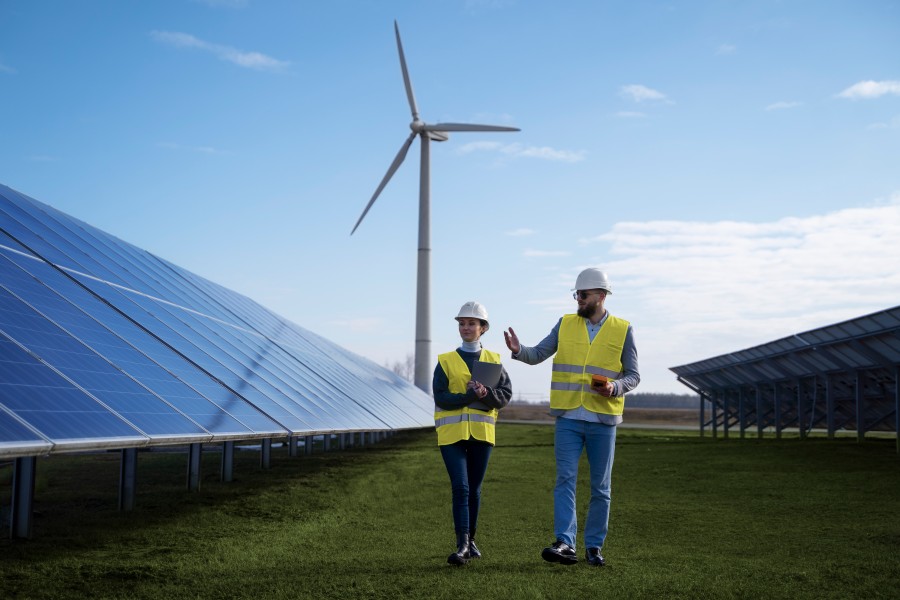Renewable Energy Trends: What’s Shaping the Future?

Back in 2015, 195 nations attending the UN Climate Change Conference (COP21) adopted the Paris Agreement. The legally binding treaty had one major goal: to restrict the global temperature rise to less than 35.6°F above pre-industrial levels. Since then, one of the key areas of focus for countries that signed the agreement has been renewable energy capacity building towards a green economy.
A decade later, we have witnessed an energy crisis fueled by geopolitical crisis, an unprecedented surge in energy demands within the power sector from developing economies, and heavy-duty energy consumption by the rapidly evolving Artificial Intelligence (AI) technology.
That said, record-breaking investment in renewable energy, coupled with rapid capacity increase, continues to be the silver lining.
What are the renewable energy trends 2025 impacting the industry? Are global renewable energy investment trends 2025 affecting this change? Let’s take a closer look at what’s happening in the sector.
The Renewable Energy Sector: What’s Happening?
Despite global economic and political headwinds, there has been sustained interest in the renewable energy sector.
Gone are the days when renewable energy and clean tech were buzzwords that governments and corporations milked for gaining social clout. The renewable energy sector is booming and how!
The first half of 2025 saw $386 billion in renewable energy investments, marking a 10% increase compared to the same period last year.
Sounds promising?
The sector is not without its share of challenges. Market changes, deployment concerns, gaps in supply chain management, and policy barriers continue to plague it.
It’s evident from the 13% decrease in asset finance for utility-scale solar and onshore wind. The US’s investments in renewables were also down by 36% in the first half of the year. Its tumultuous on-again, off-again relationship with the Paris Agreement is partly responsible, while governance policy changes contribute to the rest of the conundrum.
But that’s just one side of the story.
Certain nations are pursuing renewable energy investments with full vigor. Consider the case of the European Union-27 (EU), which has seen a 63% increase in such investments.
There’s urgency among many nations to acquire clean energy resources or build capacity. It’s a strategic move towards defining the upcoming era of renewable technology. Some of these nations are not holding back, especially when it comes to utility-scale plants.
Data from the International Energy Agency (IEA) reveals that by 2030, global renewable power capacity will increase by 4,600 gigawatts. To put things in perspective, that’s approximately the combined power generation capacity of China, Japan, and the European Union (EU).
To no one’s surprise, there’s unprecedented growth in renewable power capacity generation. While solar PV still comprises 80% of the increase, other renewable forms of energy, including wind, hydro, geothermal, and bio energy, are also contributing to capacity growth.
Here’s a quick breakdown of the different types of renewable energy and their respective capacities:
- Solar photovoltaic capacity is estimated to more than double over the next five years.
- Wind power capacity is also expected to touch 2000 GW by 2030, almost doubling during the same time period. Despite challenges, growth is expected, thanks to major investments in the sector from the US and China.
- Growth in pumped storage power plants is expected to increase hydropower’s contribution to the global renewable energy pie. At an estimated 3%, it cuts an impressive figure.
- Even geothermal energy is expected to register record highs, prompted by the actions of the United States and Southeast Asian countries like Indonesia, Japan. The Philippines, etc.
Despite renewable energy capacity levels falling short of the COP28 (UN’s Conference of the Parties), the overall outlook for the sector looks promising.
Renewable Energy Trends at A Glance
Currently, the following factors are working in tandem to influence the renewable energy sector:
1. Focus on Affordability & Renewable Capacity Generation
These are the key factors driving renewable energy investment trends 2025.
Countries are keen on investing in renewable energy resources that primarily help them with capacity building. Energy independence aside, capacity generation also provides a strategic edge to nations that have successfully built it. That’s why there’s a demand for utility-scale plants on the whole.
Exceptions to this trend exist.
The US’s decision to pause off-wind farm projects and cancellation of the “Solar for All” scheme seem counterproductive. But at the same time, it has shifted the focus of investors to smaller, independent projects.
Key tech giants like Google and Microsoft are still driving a majority of investments in the renewable energy generation sector. The emergence of energy-intensive data centers is the reason behind their investments, but in the bigger scheme of things, it spells well for the sector.
Technology that improves the utility of renewable energy and brings down the cost of deployment is equally important. Investments are happening in that vertical, too.
2. Use of Small Modular Reactors for Power Generation
Small Modular Reactors (SMRs) are scalable, low-emission alternatives to traditional fossil-fuel-based power plants. These can complement renewable power generation to cut down on greenhouse gas emissions. Lower upfront investments, faster turnaround times, and ease of deployment in commercial, industrial, and residential set-ups make them the obvious choice.
North America, Europe, and Asia are all investing in SMRs.
SMRs also have the potential to revolutionize nuclear power generation.
3. Application of Digital Twin Technology in Utility-Scale Plants
While the digital twin technology has been around for a long time, its application in utility-scale plants has been limited. Current trends indicate a wider adoption, especially in nations planning to ramp up their renewable energy production.
Why?
The tech is ideal for asset management and operational optimization. It can be used for real-time performance monitoring and deployed in predictive maintenance.
The combined need for capacity acceleration and storage will benefit from a highly optimized, effort-efficient utility-scale plant.
4. Emergence of Hybrid Facilities
Traditional utility-scale power plants are giving way to hybrid generation and storage facilities. Utility-scale projects that can simultaneously manage wind and hydro power are on the rise.
Hybrid facilities offer multiple advantages over solo power plants. Besides offering optimal land usage for renewable power generation, these state-of-the-art plants are also great for maximizing productivity, reducing overheads, and improving operational efficiency.
Such utility-scale plants also offer greater flexibility to grid operators handling variable supply and demand.
Empowering Renewable Energy Generation: The Bluence Advantage
These trends indicate the immediate need for sophisticated management of renewable energy plants that operate on a large scale.
Bluence’s all-in-one software, designed for the renewable energy value chain, provides a foolproof solution to many of the current challenges.
Its SaaS-based Remote Operation Control Center (Central SCADA) offers a real-time monitoring solution. The Asset Performance Manager (APM) uses AI-based smart analytics to help with insight-driven decision-making and ROI optimization. Then there’s the BESS Optimizer that uses intelligent automation to connect renewable power plants with market bidding systems.
Bluence offers an innovative suite of solutions that can empower the renewable energy sector in more ways than one.
Book a demo to understand which Bluence solution is an ideal fit for your requirement today.




